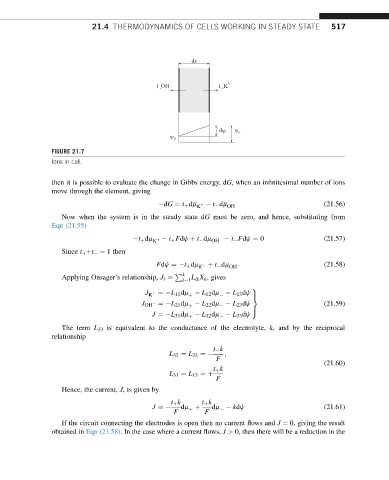Page 524 - Advanced thermodynamics for engineers
P. 524
21.4 THERMODYNAMICS OF CELLS WORKING IN STEADY STATE 517
dx
- +
t OH t K
+
-
d
FIGURE 21.7
Ions in cell.
then it is possible to evaluate the change in Gibbs energy, dG, when an infinitesimal number of ions
move through the element, giving
dG ¼ t þ dm K þ t dm OH (21.56)
Now when the system is in the steady state dG must be zero, and hence, substituting from
Eqn (21.55)
t þ dm K þ t þ Fdj þ t dm OH t Fdj ¼ 0 (21.57)
Since t þ þt ¼ 1 then
Fdj ¼ t þ dm K þ þ t dm OH (21.58)
L
P k
Applying Onsager’s relationship, J i ¼ i¼1 ik X k , gives
9
J K
þ
þ ¼ L 11 dm L 12 dm L 13 dj >
=
J OH ¼ L 21 dm L 22 dm L 23 dj (21.59)
þ
>
J ¼ L 31 dm L 32 dm L 33 dj ;
þ
The term L 33 is equivalent to the conductance of the electrolyte, k, and by the reciprocal
relationship
t k
L 32 ¼ L 23 ¼ ;
F
(21.60)
t þ k
L 31 ¼ L 13 ¼þ
F
Hence, the current, J, is given by
t þ k t þ k
J ¼ dm þ dm kdj (21.61)
F þ F
If the circuit connecting the electrodes is open then no current flows and J ¼ 0, giving the result
obtained in Eqn (21.58). In the case where a current flows, J > 0, then there will be a reduction in the

